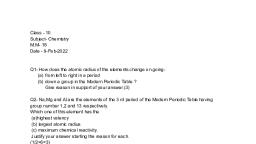Question 1 :
Use Mendeleev's periodic table to predict the formulae for the oxides of the elements 'Al'.
Question 2 :
Use Mendeleev's periodic table to predict the formulae for the oxides of the elements 'Si'.
Question 3 :
Name two elements that have two electrons in their outermost shells.
Question 4 :
Use Mendeleev's periodic table to predict the formulae for the oxides of the elements 'Ba'.
Question 5 :
Name three elements that have a single electron in their outermost shells.
Question 7 :
Use Mendeleev's periodic table to predict the formulae for the oxides of the elements 'C'.
Question 8 :
By considering their position in the periodic table, which one of the following elements would you expect to have maximum metallic characteristic?: Ga, Ge, As, Se and Br
Question 9 :
What were the criteria used by Mendeleev in creating his periodic table?
Question 10 :
Use Mendeleev's periodic table to predict the formulae for the oxides of the elements 'K'.
Question 11 :
What is the common name given to group 1 elements ?
Question 12 :
Isotopes could find a position in Mendeleev's periodic table.<br/>State whether the given statement is true or false.<br/>
Question 14 :
Which of the following statement about Mendeleev's periodic table is incorrect?
Question 16 :
Which periods were not divided into two series in the Mendeleev's periodic table?
Question 18 :
Which scientist came up with the concept of a periodic table that included all of the known elements?<br>
Question 19 :
Which among the following is not an anomalous pair in Mendeleev's periodic table?
Question 20 :
Which element has a dicey position in the modern periodic table?
Question 24 :
The properties that have increasing values with increase in atomic number for the elements of 1A are?<br/>I. Ionization energy (potential)<br/>II. Atomic radius<br/>III. Atomic mass
Question 25 :
Which group elements of the modern periodic table were placed along with alkali metals in Mendeleeff table?
Question 27 :
Electronic configuration of element T is 2, 8, 7.<br/>What is the group number of T ?
Question 28 :
Pentavalence in phosphorus is more stable when compared to that of nitrogen even though they belong to same group is due to :
Question 29 :
Assertion: Titanium, Zirconium, and Hafnium belong to the same group. The density of $Zr$ is slightly greater than titanium, But the density of Hafnium is double to that of $Zr$. 
Reason: Scandium and Titanium, as well as yttrium and zirconium, have successive atomic numbers. They show a normal trend of transition elements but their atomic numbers are not successive. The 14 elements intermediate between them have 14 electrons filled in $4f$ sub-shell. Due to the lanthanide contraction, there is a decrease in size.
Question 30 :
Atomic radii of Flourine and Neon in Angstorm units are given by?
Question 31 :
It is not possible to measure the atomic radius precisely since the electron cloud surrounding the atom does not have a sharp boundary. One practical approach to estimate the size of an atom of a non-metallic element is to measure the distance between two atoms when they are bound together by a single bond in a covalent molecule and then dividing by two. For metals, we define the term "metallic radius" which is taken as half the internuclear distance separating the metal cores in the metallic crystal. The van der Waal's radius represents the overall size of the atoms which includes its valence shell in a non bonded situation. It is the half of the distance between two similar atoms in separate molecules in a solid. The atomic radius decreases across a period and increases down the group. Generally, same trends are observed in case of ionic radius. The ionic radius of the species having the same number of electrons depends on the number of protons in their nuclei.<br/><br/>Which of the following statements is correct?
Question 32 :
A solid AB has NaCl structure. If radius of${{\text{A}}^{\text{ + }}}$ is 100 pm. What is the radius of${{\text{B}}^{\text{ - }}}$ ion ?
Question 34 :
Assertion: According to Mendeleev, the properties of elements are a periodic function of their atomic weights.
Reason: Mendeleev left the gap under aluminium and a gap under silicon, and called these elements Eka-Aluminium and Eka-Silicon.























